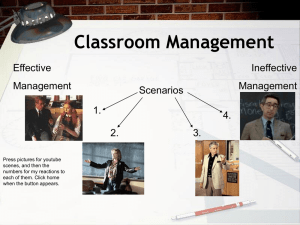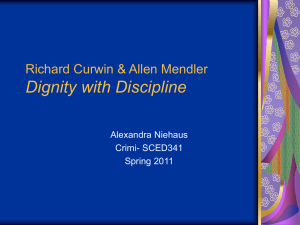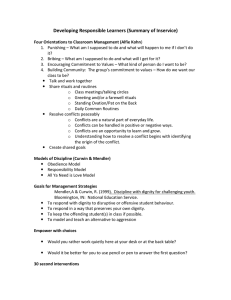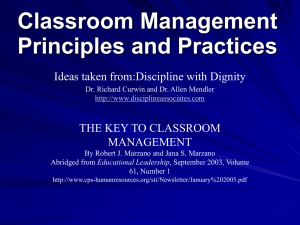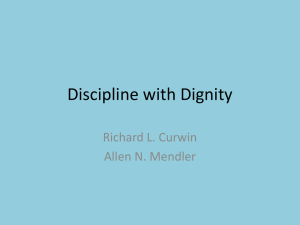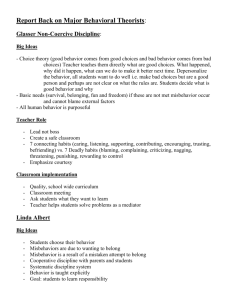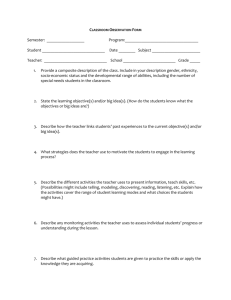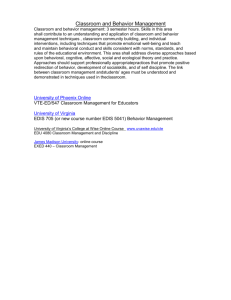Behavioral Interventions for Adolescents
advertisement
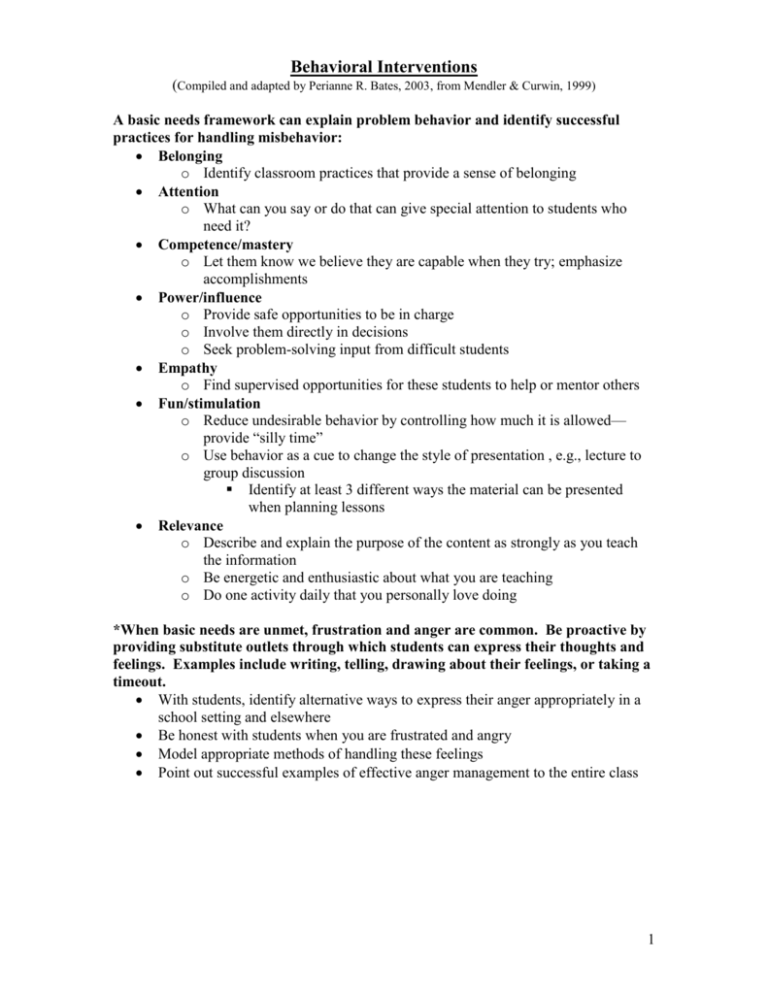
Behavioral Interventions (Compiled and adapted by Perianne R. Bates, 2003, from Mendler & Curwin, 1999) A basic needs framework can explain problem behavior and identify successful practices for handling misbehavior: Belonging o Identify classroom practices that provide a sense of belonging Attention o What can you say or do that can give special attention to students who need it? Competence/mastery o Let them know we believe they are capable when they try; emphasize accomplishments Power/influence o Provide safe opportunities to be in charge o Involve them directly in decisions o Seek problem-solving input from difficult students Empathy o Find supervised opportunities for these students to help or mentor others Fun/stimulation o Reduce undesirable behavior by controlling how much it is allowed— provide “silly time” o Use behavior as a cue to change the style of presentation , e.g., lecture to group discussion Identify at least 3 different ways the material can be presented when planning lessons Relevance o Describe and explain the purpose of the content as strongly as you teach the information o Be energetic and enthusiastic about what you are teaching o Do one activity daily that you personally love doing *When basic needs are unmet, frustration and anger are common. Be proactive by providing substitute outlets through which students can express their thoughts and feelings. Examples include writing, telling, drawing about their feelings, or taking a timeout. With students, identify alternative ways to express their anger appropriately in a school setting and elsewhere Be honest with students when you are frustrated and angry Model appropriate methods of handling these feelings Point out successful examples of effective anger management to the entire class 1 Determining If a Strategy is Worth Using Does using the method preserve dignity or cause humiliation? Is the method primarily obedience-oriented or does it teach responsibility? o Responsibility-based discipline involves setting limits and providing choices and consequences o Places control of the behavior on the child by teaching decision-making within the context of accountability How does the method affect a student’s motivation to learn? Does the method lead to a commitment to change? Does the method work? Seven Goals for Successful Discipline o Create a caring classroom o Teach self-control o Promote concern for others o Establish clearly defined limits o Emphasize responsibility rather than obedience o Teach conflict-resolution skills Seven steps to success Five answers to give Two-person problem solving SODA process (situation, options, disadvantages, advantages) Class planning and problem solving Plan to help students resolve conflict o Combine and network with others *Allow for individuals needs and differences You may or may not want to use an “across the board” approach—focus on the individual student’s present needs Three Kinds of Strategies Crisis Strategies Provide students and teachers with a sense of security o Remind yourself that you are not trying to solve the problem at this point o Determine what crises you might face o Determine if you would need help o Determine how you will quickly get the help you need o Identify what you want the other students to do o Identify what you need to do o After the crisis, try to determine what caused it Short-term strategies Designed to stop misbehavior while preserving the dignity of the student and the teacher Goal is to redirect the energy of the class back to instruction 2 In the conflict cycle, angry students recreate their feeling in others. Use counteraggressive measures to defuse: calm, positive, caring, concerned, and empathetic o Respond with dignity to offensive student behaviors o Respond in a way that preserves your own dignity o Keep the offending student(s) in class if at all possible o Model and teach alternatives to aggression “I” messages—whole class or individual Reality Therapy PEP (privacy, eye contact, proximity) Nonverbal PEP (cards or Post-it notes) LADD (listening, acknowledging, agreeing, deferring) Long-term strategies Understand and use basic needs frame of reference to structure classroom and learning Develop responsibility by using limits, providing choices and consequences Consider both in- and out-of-school factors affecting behavior o Teach relaxation techniques o Encourage students to exercise o Teach social and emotional skills Managing anger Negotiating Adopting another’s perspective Alternative solutions to disagreements Unconventional Discipline Strategies Use humor and nonsense Agree with refusals Deal calmly with the “what are you going to do about it?” response Answer improbably Thank the student for appropriate behavior before it occurs Show your own imperfections Use audio- or videotape Occasionally throw a tantrum in a controlled fashion Behave paradoxically Reduce stress o Breathing methods o Guided visualizations o Progressive muscle relaxation *Remembering why we are there in the first place (we love teaching and our students; we are committed to developing productive, positive members of society,…) 3 References Behavioral Interventions/Social Skills Begun, R. W. (Ed.). (1996). Ready-to-use social skills lessons & activities for grades 7-12. West Nyack, NY: Center for Applied Research in Education. Curwin, R. L. (1992). Rediscovering hope: Our greatest teaching strategy. Bloomington, IN: National Education Service. Danforth, S., & Boyle, J. R. (2000). Cases in Behavior Management. Upper Saddle River, NJ: Prentice Hall. Eggert, L., Nicholas, L., & Owen, L. (1999). Reconnecting youth: A peer group approach to building life skills. Bloomington, IN: National Education Service. Jageman, L. (1998) Classroom Management. Unpublished, Ohio University at Athens. Long, N. J., Morse, W. C., & Newman, R. G. (1996). Conflict in the classroom: The education of at-risk and troubled students (5th ed.). Austin, TX: Pro-ed. Mendler, A. N. (1992) What do I do when…?: How to achieve discipline with dignity in the classroom. Bloomington, IN: National Education Service. Mendler, A. N. (1997). Power struggles: Successful techniques for educators. Rochester, NY: Discipline Associates. Mendler, A. N. & Curwin, R. L. (1999). Discipline with dignity for challenging youth. Bloomington IN: National Education Service. Pollack, W. (1998). Real boys: Rescuing our sons from the myths of boyhood. New York: Random House. Skiba, R. J. & Peterson, R. L. (2000). School discipline at a crossroads: From zero tolerance to early response. Exceptional Children, 66 (3), 335-346. Sprick, R. S., & Howard, L. M. (1995). The teacher’s encyclopedia of behavior management: 100 problems/500 plans. Longmont, CO: Sopris West. Walker, H., Colvin, G., & Ramsey, E. (1996). Antisocial behavior in school: Strategies and best practices [Review of the book Antisocial behavior in school: Strategies and best practices]. Behavioral Disorders, 21 (3), 248-256. Walker, H. M., Horner, R. H., Sugai, G., Bullis, M., Sprague, J. R., Bricker, D., & Kaufman, M. J. (1996). Integrated approaches to preventing antisocial behavior patterns among school-age children and youth. Journal of Emotional and Behavioral Disorders, 4 (4), 194-209. 4 . 5
